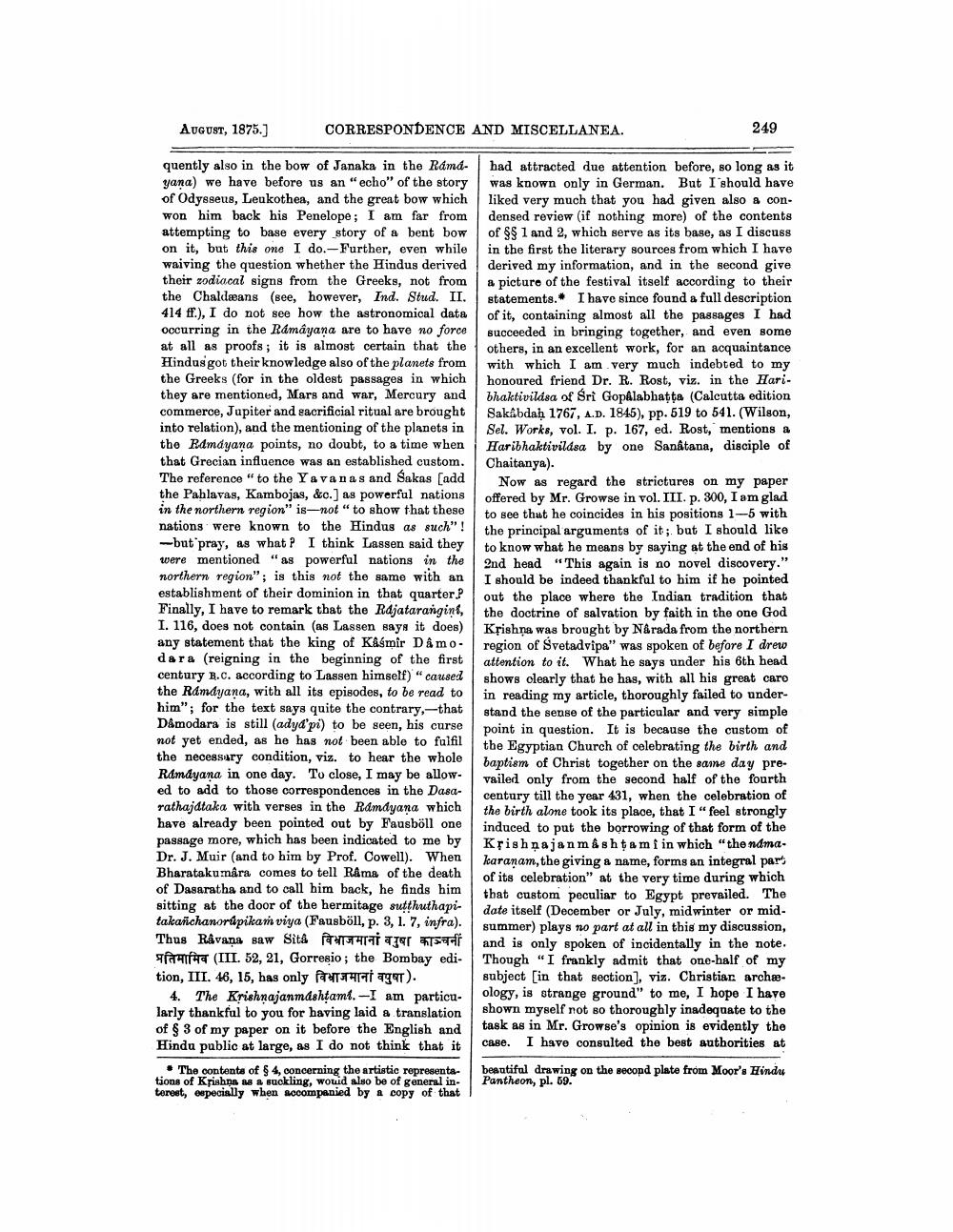________________
August, 1875.]
CORRESPONDENCE AND MISCELLANEA.
249
quently also in the bow of Janaka in the Ramd. yana) we have before us an "echo" of the story of Odysseus, Leukothea, and the great bow which won him back his Penelope; I am far from attempting to base every story of a bent bow on it, but this one I do.-Further, even while waiving the question whether the Hindus derived their zodiacal signs from the Greeks, not from the Chaldæans (see, however, Ind. Stud. II. 414 ff.), I do not see how the astronomical data occurring in the Ramayana are to have no force at all as proofs; it is almost certain that the Hindus got their knowledge also of the planets from the Greeks (for in the oldest passages in which they are mentioned, Mars and war, Mercury and commerce, Jupiter and eacrificial ritual are brought into relation), and the mentioning of the planets in the Ramdwana points, no doubt, to a time when that Grecian influence was an established custom. The reference " to the Yavanas and Sakas [add the Pablavas, Kambojas, &c.) as powerful nations in the northern region" is-not" to show that these nations were known to the Hindus as such"! --but pray, as what? I think Lassen said they were mentioned "as powerful nations in the northern region"; is this not the same with an establishment of their dominion in that quarter.P Finally, I have to remark that the Rdjatarangin, I. 116, does not contain (as Lassen says it does) any statement that the king of Kasmir Damo. dara (reigning in the beginning of the first century B.C. according to Lassen himself) "caused the Ramdyana, with all its episodes, to be read to him"; for the text says quite the contrary,--that Damodara is still (adydpi) to be seen, his curse not yet ended, as he has not been able to fulfil the necessary condition, viz. to hear the whole Ramayana in one day. To close, I may be allowed to add to those correspondences in the Dasarathajdtaka with verses in the Ramdyana which have already been pointed out by Fausböll one passage more, which has been indicated to me by Dr. J. Muir (and to him by Prof. Cowell). When Bharatakumara comes to tell Râma of the death of Dasaratha and to call him back, he finds him sitting at the door of the hermitage sutthuthapitakañchanorúpikaṁ viya (Fausböll, p. 3, 1. 7, infra). Thus Ravana saw Sita विधाजमानां वपुषा काञ्चनीं SETH (III. 52, 21, Gorresio; the Bombay edi. tion, III. 46, 15, has only fararti agar).
4. The Krishnajanmashtami. -I am particularly thankful to you for having laid a translation of § 3 of my paper on it before the English and Hindu public at large, as I do not think that it
had attracted due attention before, so long as it was known only in German. But I should have liked very much that you had given also & condensed review (if nothing more) of the contents of SS 1 and 2, which serve as its base, as I discuss in the first the literary sources from which I have derived my information, and in the second give a picture of the festival itself according to their statements. I have since found a full description of it, containing almost all the passages I had succeeded in bringing together, and even some others, in an excellent work, for an acquaintance with which I am very much indebted to my honoured friend Dr. R. Rost, viz. in the Haribhaktivildsa of Sri Gopalabhatta (Calcutta edition Sakabdaḥ 1767, A.D. 1845), pp. 519 to 541. (Wilson, Sel. Works, vol. I. p. 167, ed. Rost, mentions a Haribhaktivildsa by one Santana, disciple of Chaitanya).
Now as regard the strictures on my paper offered by Mr. Growse in vol. III. p. 300, I am glad to see that he coincides in his positions 1-5 with the principal arguments of it; but I should like to know what he means by saying at the end of his 2nd head "This again is no novel discovery." I should be indeed thankful to him if he pointed out the place where the Indian tradition that the doctrine of salvation by faith in the one God Krishna was brought by Nárada from the northern region of Svetadvipa" was spoken of before I drew attention to it. What he says under his 6th head shows clearly that he has, with all his great caro in reading my article, thoroughly failed to understand the sense of the particular and very simple point in question. It is because the custom of the Egyptian Church of celebrating the birth and baptism of Christ together on the same day prevailed only from the second half of the fourth century till the year 431, when the celebration of the birth alone took its place, that I "feel strongly induced to put the borrowing of that form of the Krishnajanmashtami in which "the ndma. karanam, the giving a name, forms an integral par! of its celebration" at the very time during which that custom peculiar to Egypt prevailed. The date itself (December or July, midwinter or midsummer) plays no part at all in this my discussion, and is only spoken of incidentally in the note. Though "I frankly admit that one-half of my subject [in that section], viz. Christiac archæ ology, is strange ground" to me, I hope I have shown myself not so thoroughly inadequate to the task as in Mr. Growse's opinion is evidently the case. I have consulted the best authorities at
• The contents of $ 4, concerning the artistic representations of Krishna as a suckling, wouid also be of general interest, especially when accompanied by a copy of that
beautiful drawing on the secopd plate from Moor's Hindu Pantheon, pl. 59.




